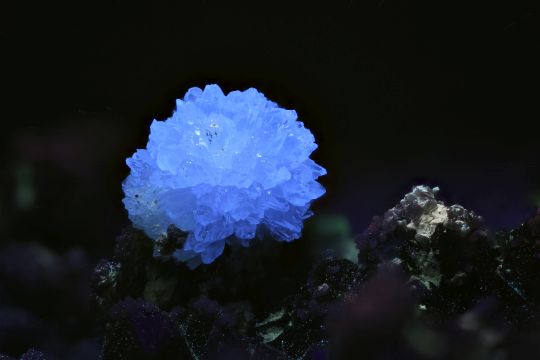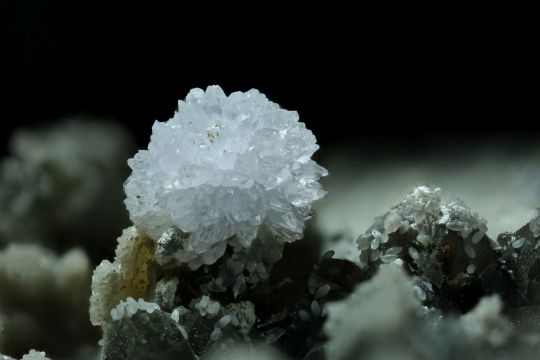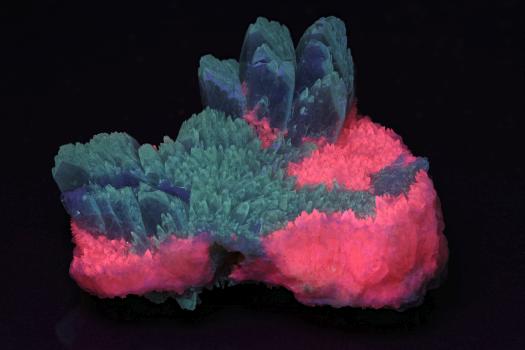Sulfates - Molybdates - Tungstates
White light, long wave and midrange UV resp.
Anglesite: Monteponi, Sardinia, Italy.
There is little literature on the fluorescence of this mineral. Often lead minerals fluoresce yellow or yellowish by "self-activation", thus intrinsically. In this case, the magenta fluorescence is clearly excited by something else. We will keep you informed of any developments.
Baryte: Haití mine, Cabezo de San Ginés, San Ginés de la Jara, Sierra Minera de Cartagena-La Unión, Cartagena, Murcia, Spanje
Platy baryte crystals, covered with a white crust: gypsum, according to the label, but more likely calcite/aragonite (according to our knowledgeable in-house geologist Iván Blanco). The crust fluoresces white (humic acids) and a little green (presumably a little uranyl).
White light and short wave UV resp.
Gypsum: Saragossa, Spain.
Mitre-shaped water clear crystals on matrix of white gypsum crystals. Very strong white fluorescence due to the presence of organic material.
White light and long wave UV resp.
Scheelite: Yaogangxian Mine,, Yaogangxian W-Sn ore field, Yizhang Co., Chenzhou Prefecture, Hunan Province, China
The blue fluorescence of scheelite under short wave UV is intrinsic. It is the result of charge transfer between one of the oxygen atoms in the tungstate ion and the central atom in the ion, tungsten. An electron from one of the oxygen atoms "jumps" from the excited state to one of the incompletely occupied electron shells of the tungsten ion. The same thing happens in powellite. The red fluorescence in midrange UV is completely due to elements of the lanthanides series, the so-called "rare earth elements".
Powellite: Jalgaon District, Maharashtra, India
The fluorescence of powelliet is intrinsic and its mechanism is also identical to that of scheelite. The interatomic distances R (Mo-O) and R (W-O) lie between 177-178 pm (picometer). Both atomic groups are thus perfectly interchangeable. When scheelite contains even a little molybdate, its fluorescent color will evolve, with rising Mo-concentration, from blue over white to yellow.
White light and midrange UV resp.
White light, midrange and short wave UV resp.
Celestine on aragonite: Caltanissetta Province, Sicily, Italy
The grey fluorescence of celestine is probably caused by embedded organic material. The own color of this celestine is grey-green, causing the normal tan fluorescence of the humic acids to be discolored to a greenish-grey color. The red fluorescence of the aragonite is caused by samarium and some humic acids.
Long wave UV
Anglesite: Monteponi, Sardinia, Italy.
There is little literature on the fluorescence of this mineral. Often lead minerals fluoresce yellow or yellowish by "self-activation", thus intrinsically. The violet light is a mere reflection of light that leaks through the filters of the UV source.
White light and SW UV resp.
Powellite-Cu : Jardinera No. 1 Mine, Inca de Oro, Chañaral Province, Atacama Region, Chile
The fluorescence of powelliet is intrinsic and its mechanism is also identical to that of scheelite. Copper replaces a substantial part of the main cation: calcium. This 'cupro-powellite' is colored deep green as a result.
White light and SW UV resp.
Scheelite: Dongshan Mine, Xianghualing Sn-polymetallic ore field, Linwu Co., Chenzhou Prefecture, Hunan Province, China
The blue fluorescence of scheelite under short wave UV is intrinsic. On this specimen, a scheelite- and a calcite twin crystal are perched side by side. The calcite contains a little lead and manganese and fluoresces red as a result, in beautiful contrast with the blue fluorescence of the scheelite. Both minerals sit on a matrix of fluorite, which is nearly non-fluorescent.
White light and SW UV resp.


Creedite:
Navidad Mine?, Abasolo, Rodeo, Mun. de Rodeo, Durango, Mexico
Creedite is not generally known for its fluorescence. It doensn't fluoresce consistently and when it does, it's not always for the same reason. Specimens from La Paz, Bolivia, in my collection fluoresce a lot like calcite and gypsum: light blue-green. This is usually caused by some organic matter, mostly humic acids. This creedite specimen from Durango fluoresces a clear violet-blue, clearly different from the blue-green fluorescence of the Bolivian specimen. Both specimens have a distinct greenish phosphorescence, which is a clear indication that they both contain polycyclic aromatic hydrocarbons (humic acids). It appears that the Mexican specimen also contains some gadolinium, cerium and europium that account for a violet-blue fluorescence. In this specimen, the ratio between the violet-blue and the bleu-green fluorescence sways towards the violet blue, but both are present. Go see the spectrum for more details.
White light and Midrange UV resp.
White light and short-wave UV resp.
Caracolite
Caracoles, Sierra Gorda District, Antofagasta Province, Antofagasta Region, Chile
Caracolite is one of the lesser known fluorescent minerals. It is a lead mineral and lead is a strongly fluorescent ion in many minerals, even in glass. The violet blue fluorescent mineral is caracolite, the light green fluorescent has not been identified but might be anhydrite.
Baryte on calcite Sidmouth, East Devon, Devon, England, UK
Beautiful find by Tom Costes (MKA, Nautilus and Crystal Classics)! Strongly fluorescent barite crystals on a weakly red fluorescent matrix of calcite. Oddly enough, the fluorescence of this baryte is completely identical to that of Franklin, New Jersey. The spectrum proves that unequivocally.
Click on the photo for magnification.
Anglesite
Baryte
Gypsum
Scheelite
Powellite
Celestine on aragonite
Anglesite
Powellite-Cu
Scheelite
Creedite
Caracolite
Baryte on calcite matrix
Wulfenite
Wulfenite is not often seen in fluorescent mineral displays. There are three good reasons for this. First of all, the fluorescence of wulfenite is not really consistent: some specimens do it, others do not. Secondly, if you do have a fluorescent wulfenite, you will hardly observe its fluorescence under an ordinary blacklight. The fluorescence is far too weak in relation to the minerals that we usually put in such a display. Thirdly, wulfenite specimens with a good coverage of their surface with undamaged crystals are only available to the very wealthy collector. You ‘d pay fortunes for it.
A slightly less aesthetic specimen with perfect small crystals is usually affordable. Moreover, from a scientific point of view, it is certainly as interesting. The image width of the photos is 6 mm. The cause of fluorescence is the same as with powellite, namely charge transfer within the complex [MoO4]2- molecule. Logically, the fluorescence color is more or less the same as that of powellite, albeit slightly more orange.
The exposure was done with two light sources, each containing 7 1W LEDs of 365 nm. Such concentrated UV violence creates a strong enough fluorescence to be photographed.
